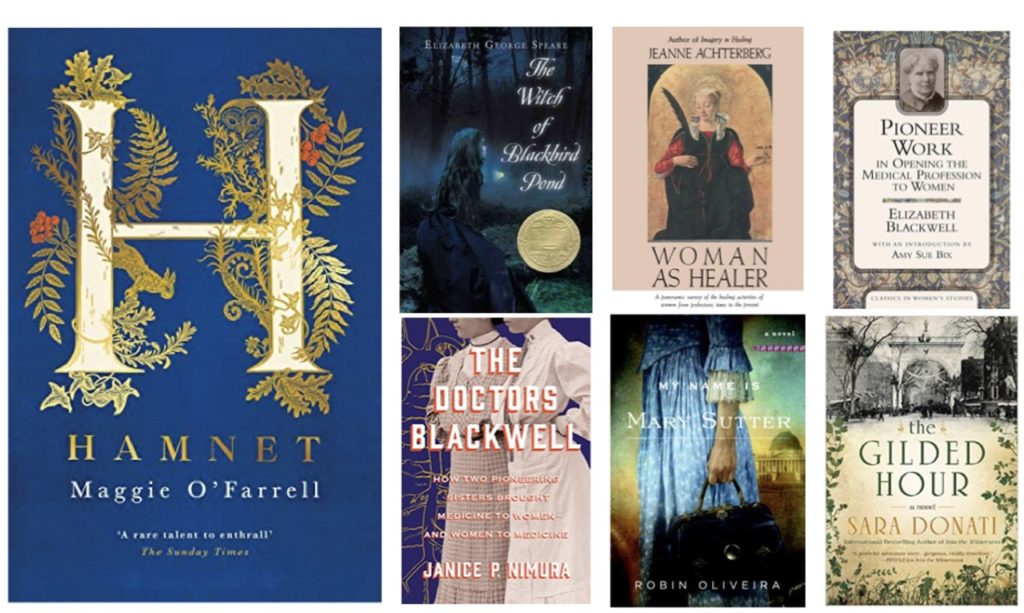It’s time for another adventure in Kate’s 6 Degrees of Separation Meme from her blog, Books Are My Favourite and Best. We are given a book to start with, and from there we free associate six books.
For this first 6 Degrees of 2021, we start with the winner of the 2020 Women’s Prize for Fiction, Hamnet by Maggie O’Farrell. This book is next up on my to-read list. I understand from reading about this highly praised novel that it portrays the death of Shakespeare’s son, Hamnet, at age 11 in the plague of 1596.
But the book focuses not on the playwright, but on the child’s mother, Agnes, who learns from her mother about the power of plants and about understanding her own premonitions. In other words, Agnes is a witch.
1. Thinking about Agnes’s role immediately brought to mind The Witch of Blackbird Pond by Elizabeth George Speare. In this novel for young people an orphaned young woman, Kit Tyler, travels from Barbados to live with a relative in the Connecticut Colony in 1687. Since I grew up in Connecticut near the place where this novel is set, reading it was de rigueur when I was in elementary school. I reread it a few years ago and was pleased to realize that the portrait of Hannah, an ostracized Quaker woman whom young Kit befriends, still fulfills the standard stereotype of a witch.
2. In her nonfiction work Woman as Healer, Jeanne Achterberg examines the role of women in the Western healing traditions, from their honored position as healers in ancient cultures through the persecution of such healers as witches in the Middle Ages and then into more modern roles of women as midwives, then nurses, and now physicians.
3. In 1849 Elizabeth Blackwell became the first woman to earn a medical degree in the United States. In 1895 she published her autobiography, Pioneer Work in Opening the Medical Profession to Women.
4. Just a few days ago I discovered a new book scheduled to be published by W.W. Norton later this month: The Doctors Blackwell: How Two Pioneering Sisters Brought Medicine to Women and Women to Medicine by Janice P Nimura. The book focuses on the life work of Elizabeth Blackwell and her younger sister, Emily Blackwell, who also became a physician.
5. At the outbreak of the Civil War in the United States, the Blackwell sisters lead efforts to organize women to help care for wounded soldiers. Their efforts met with strong opposition from the United States Sanitary Commission, whose male leaders resented the women’s incursion into the traditionally male-dominated profession of physician. The novel My Name Is Mary Sutter by Robin Oliveira presents the difficulties a young midwife faces as she tries to train as a physician with a male doctor during the war.
6. The novel The Gilded Hour by Sara Donati, set in New York City in 1883, provides a look at how women worked to defend their right to practice and to define their role as physicians during the latter half of the nineteenth century. Anna Savard, a graduate of the Woman’s Medical School, works to protect and care for immigrant and orphaned children on the city streets and in the rudimentary orphanages.
Bonus: The second book in this series, Where the Light Enters, set in 1884, tells the story of Anna’s cousin, Sophie, an obstetrician and the orphaned daughter of free people of color.
I have very much enjoyed this exercise in exploring how women have experienced and redefined their role as healers over the centuries.
© 2021 by Mary Daniels Brown


Great connections! I just posted mine today too!
Thanks, Dani.
Great chain, but… I wouldn’t call healers and people who “get” herbal medicine witches. No matter. By the way, Robin Oliveira wrote a 2nd novel with Stutter called The Winter Sisters, which takes place around the disastrous blizzard of 1888. You might like it.
Davida, I wouldn’t call healers witches, either, but a lot of people did, and thereby arose all the witch hunts. I didn’t know about The Winter Sisters but will definitely check it out.
I like how you used Agnes’ status as a witch as your link, I don’t think, I’ve seen that in other chains. Amazing, how many jobs women were not meant to have. Good to see that some things have changed!